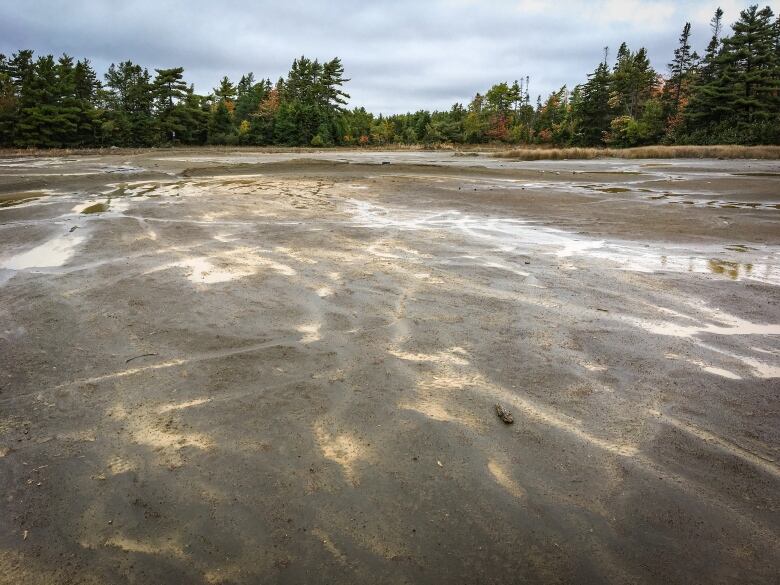For 150 years, dozens of abandoned former gold mines have littered Nova Scotia, some harbouring residue with sky-high arsenic levels.
Earlier this year, the province announced it will spend $48 million to clean up two of the worst offenders — Goldenville, near Sherbrooke on the Eastern Shore, and Montague Gold Mines, in Dartmouth.
But that task is daunting.
The two sites were mined extensively from the 1860s to the early 1940s. Back then, environmental regulations were non-existent, or, at best, inadequate.
Miners used liquid mercury to extract gold from crushed rock, and the leftover material, called tailings, was simply dumped in the closest body of water.
Arsenic, which occurs naturally in rock, was released as part of the mining process.

Arsenic levels at the two sites are astonishing. The Nova Scotia Environment Department's human health soil quality guideline is 31 mg/kg, but at Goldenville, levels of up to 200,000 mg/kg were found, and at Montague Gold Mines, the tailings had arsenic levels of up to 41,000 mg/kg.
The Canadian Council of Ministers of the Environment's human health and ecological soil quality guidelines for inorganic mercury is 6.6mg/kg. At Goldenville, mercury levels of up to 48 mg/kg were found, and at Montague Gold Mines, they were up to 8.4 mg/kg.

Last month, the province revealed plans to remediate Montague and Goldenville — plans that could serve as a template for future cleanups of other former gold mines.
The plans, pitched by a consortium of companies selected by the province through a tendering process, involve excavating the tailings with the greatest contamination to a depth of two metres and placing them in a lined containment cell.
"You're controlling what water can get at them and more or less entombing them so that they don't have a negative effect on the environment any longer," said Donnie Burke, the executive director of environmental analysis and remediation for Nova Scotia Lands, a provincial Crown corporation responsible for environmental cleanups.
Those areas will then be covered with clean backfill.

At Montague, two containment cells will each be 95 metres by 95 metres and five metres high, made with a berm, an impermeable liner, a leachate collection system and an impermeable cover system. At Goldenville, the same structures will be built, but one will be 180 metres by 180 metres and the other will by 135 metres by 135 metres.
The two sites will also require a water treatment system as well as a wall to prevent contaminated water from leaving the excavation zone.
In other areas with lower levels of contamination, a protective, low-permeability cover will be placed on top of the tailings to prevent precipitation from getting into the contaminated soils. That barrier will then be covered with soil and vegetation.
The sites are challenging to clean up, the reports note, because of the sheer size of the tailings areas and the fact that some areas flood seasonally.
Burke said the plans are still subject to approval. Cleanup will likely take place over about five years, he said.

A Saint Mary's University scientist who studies gold mine contamination and remediation said she is impressed with the reports.
"It is good gathering of information and identifying the gaps that are required before you're even able to start thinking about remediating the area," said Linda Campbell, the director of the school of environment at the university. "I really applaud the people who are involved in this report."
Campbell said one detail she'd like to see in future plans for the sites is a good monitoring strategy to catch any leaks in the liners.
"The challenge with geotextile clay liners, that kind of thing, they will fail at some point. They will," Campbell said, noting that failure would happen in a matter of decades. "Nothing lasts forever and that's just one of them."
Contaminants found downstream
Over time, the tailings have been transported downstream from the initial mine sites. At Montague, the contaminated material has been found in nearby Barry's Run. At Goldenville, tailings have been found six kilometres away, but the report notes they "have likely been deposited further downstream, including in the marine environment."
In August, the Halifax Regional Municipality warned residents not to enter the water or eat fish from Barry's Run due to arsenic contamination from the mine site.
Ingesting arsenic in moderate levels over a lifetime can cause cancer, according to the provincial government, while ingesting high concentrations over a short period of time can cause sickness. Daily exposure to dust from tailings can also cause health effects.
Today, Nova Scotians are unlikely to be affected by mercury from gold mine tailings because their exposure is low, the province says, but long-term exposure at low levels can cause some minor health effects, and people are advised to avoid tailings.
https://www.cbc.ca/news/canada/nova-scotia/gold-mine-remediation-montague-goldenville-1.5308754
2019-10-12 09:00:00Z
CBMiX2h0dHBzOi8vd3d3LmNiYy5jYS9uZXdzL2NhbmFkYS9ub3ZhLXNjb3RpYS9nb2xkLW1pbmUtcmVtZWRpYXRpb24tbW9udGFndWUtZ29sZGVudmlsbGUtMS41MzA4NzU00gEgaHR0cHM6Ly93d3cuY2JjLmNhL2FtcC8xLjUzMDg3NTQ
Bagikan Berita Ini














0 Response to "How do you clean up a contaminated 150-year-old gold mine? - CBC.ca"
Post a Comment